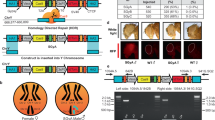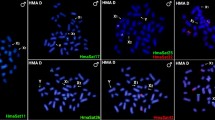Abstract
Accumulating evidence suggests that haploinsufficiency of a dosage-sensitive gene(s) in human chromosome 9p24.3 is responsible for the failure of testicular development and feminisation in XY patients with monosomy for 9p. We have used molecular cytogenetic methods to characterise the sex-reversing 9p deletions in two XY females. Fluorescence in situ hybridisation (FISH) with YACs from the critical 9p region containing an evolutionarily conserved sex-determining gene, DMRT1, is a very fast and reliable assay for patient screening. Comparative YAC mapping on great ape and Old and New World monkey chromosomes demonstrated that the critical region was moved from an interstitial position on the ancestral primate chromosome to a very subtelomeric position in chimpanzee and humans by a pericentric inversion(s). Pathological 9p rearrangements may be the consequence of an evolutionary chromosome breakpoint in close proximity to the sex-reversal region.
Similar content being viewed by others
Article PDF
Author information
Authors and Affiliations
Corresponding author
Rights and permissions
About this article
Cite this article
Shan, Z., Zabel, B., Trautmann, U. et al. FISH mapping of the sex-reversal region on human chromosome 9p in two XY females and in primates. Eur J Hum Genet 8, 167–173 (2000). https://doi.org/10.1038/sj.ejhg.5200431
Received:
Revised:
Accepted:
Published:
Issue Date:
DOI: https://doi.org/10.1038/sj.ejhg.5200431
Keywords
This article is cited by
-
Unbalanced segregation of a paternal t(9;11)(p24.3;p15.4) translocation causing familial Beckwith-Wiedemann syndrome: a case report
BMC Medical Genomics (2019)
-
Duplication 9p and their implication to phenotype
BMC Medical Genetics (2014)
-
Characterization of a complex rearrangement involving duplication and deletion of 9p in an infant with craniofacial dysmorphism and cardiac anomalies
Molecular Cytogenetics (2012)
-
Partial trisomy and partial monosomy resulting from a reciprocal segregating in a large family
The Indian Journal of Pediatrics (2008)
-
Testicular germ cell tumor susceptibility genes from the consomic 129.MOLF-Chr19 mouse strain
Mammalian Genome (2007)



